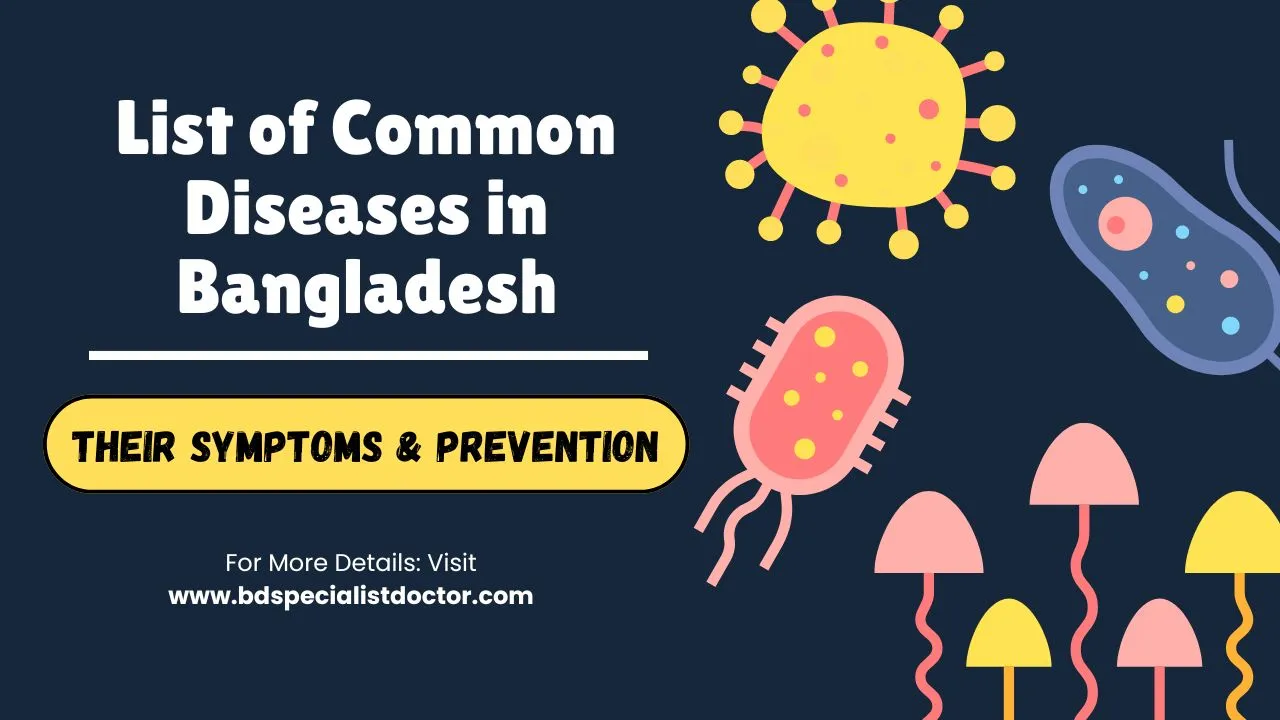List of Common Diseases in Bangladesh, Symptoms, and their Prevention
Bangladesh, a densely populated country in South Asia, faces a range of public health challenges due to various socio-economic, environmental, and climatic factors. The country’s health system deals with both communicable and non-communicable diseases, impacting the population’s overall well-being and economic productivity.

Here is a list of common diseases that you should know. The below article will help you to know about it.
Communicable Diseases
Communicable diseases, or infectious diseases, are caused by pathogens such as bacteria, viruses, fungi, and parasites. These diseases are transmitted through direct contact, contaminated food and water, insect bites, and other vectors. In Bangladesh, communicable diseases are prevalent due to factors such as poor sanitation, lack of clean drinking water, and inadequate healthcare infrastructure.
Examples of Common Communicable Diseases:
- Dengue Fever: Transmitted by Aedes mosquitoes, leading to high fever, severe headache, and joint pain.
- Cholera: Caused by Vibrio cholerae bacteria, resulting in severe diarrhea and dehydration.
- Tuberculosis (TB): A bacterial infection spread through the air, causing persistent cough and chest pain.
- Hepatitis A: A viral infection spread through contaminated food and water, causing liver inflammation.
- Malaria: Caused by Plasmodium parasites transmitted by Anopheles mosquitoes, leading to fever, chills, and sweats.
Non-Communicable Diseases
Non-communicable diseases (NCDs) are chronic conditions not transmitted from person to person. They are often associated with lifestyle factors such as poor diet, lack of physical activity, and tobacco use. In Bangladesh, the burden of NCDs is increasing, posing significant challenges to the healthcare system.
Examples of Common Non-Communicable Diseases:
- Diabetes: A metabolic disorder characterized by high blood sugar levels, leading to complications like heart disease and kidney failure.
- Hypertension (High Blood Pressure): A chronic condition increasing the risk of heart disease and stroke.
- Cardiovascular Diseases: Conditions affecting the heart and blood vessels, including heart attacks and strokes.
- Chronic Respiratory Diseases: Including asthma and chronic obstructive pulmonary disease (COPD).
- Cancer: Various forms, including lung, breast, and cervical cancer, are becoming more prevalent.
Factors Contributing to Disease Burden
Several factors contribute to the high burden of diseases in Bangladesh:
- Poverty and Overcrowding: High population density and poverty lead to inadequate living conditions, promoting the spread of infectious diseases.
- Climate and Geography: The tropical climate and frequent flooding create favorable conditions for mosquito-borne diseases like dengue and malaria.
- Healthcare Access: Limited access to quality healthcare services, especially in rural areas, hampers disease prevention and treatment efforts.
- Nutrition and Lifestyle: Poor nutrition and unhealthy lifestyles contribute to the rise in non-communicable diseases.
Preventive Measures: How to Prevent it
To combat these common diseases, Bangladesh has implemented various preventive measures:
- Vaccination Programs: Nationwide immunization campaigns target diseases like polio, measles, and hepatitis.
- Public Health Campaigns: Efforts to raise awareness about hygiene, sanitation, and healthy lifestyles.
- Vector Control: Measures to control mosquito populations and prevent diseases like dengue and malaria.
- Improved Healthcare Access: Expanding healthcare services, particularly in rural areas, to ensure early diagnosis and treatment.
In conclusion,
Addressing the burden of common diseases in Bangladesh requires a multi-faceted approach, including improving healthcare infrastructure, promoting public health education, and implementing effective disease prevention and control measures. By tackling both communicable and non-communicable diseases, Bangladesh can improve the health and well-being of its population and foster socio-economic development.
